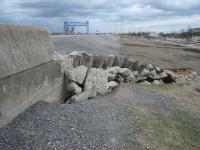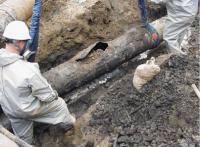-
Protecting the grid from weather geomagnetic storms
On 9 March 1989, a huge cloud of solar material exploded from the sun, twisting toward Earth. When this cloud of magnetized solar material — called a coronal mass ejection, or CME — reached our planet, it set off a chain of events in near-Earth space that ultimately knocked out power to the Canadian province Quebec for about nine hours. Though CMEs hit Earth often, those with the potential to shut down an entire power grid are rare — and scientists want to make sure that next time, we are prepared. Because space weather can have — at its very worst — such significant consequences, scientists from NASA are creating models to simulate how space weather can impact our power grid.
-
-
Four billion people affected by severe water scarcity

There are four billion people worldwide who are affected by severe water scarcity for at least one month a year. This alarming figure is much higher than was previously thought. In the first research of its kind, researchers identified people’s water footprint from month to month, and compared it to the monthly availability of water.
-
-
Russian govt. behind attack on Ukraine power grid: U.S. officials
Obama officials said that Russian hackers were behind a December 2015 cyberattack on Ukraine’s power grid. The attack caused power outages and blackouts in 103 cities and towns across Ukraine. Elizabeth Sherwood-Randall, deputy Energy Secretary, made the comments to a gathering of electric power grid industry executives.
-
-
Better Greenland, Antarctica sheet modeling helps predict sea-level rise
The Greenland and Antarctic ice sheets will make a dominant contribution to twenty-first century sea-level rise if current climate trends continue. However, predicting the expected loss of ice sheet mass is difficult due to the complexity of modeling ice sheet behavior. Better to understand this loss, a team of Sandia National Laboratories researchers has been improving the reliability and efficiency of computational models that describe ice sheet behavior and dynamics.
-
-
Extrusion technique creates new fuel from depleted uranium
Advanced nuclear reactors will use new types of fuel. To ensure such systems are safe, experimental fuel samples must be fabricated and tested in safe research environments. Marking an important step toward the advancement of a new type of reactor, Idaho National Laboratory (INL) employees recently completed the first successful test of fabrication equipment in the Experimental Fuels Facility (EFF). Specifically, they finished depleted uranium extrusions — a process of shaping material by forcing it through a die.
-
-
World economy unlikely to stop relying on fossil fuels: Study
On the heels of last year’s historic climate agreement in Paris, a new study concludes that fossil fuel consumption is likely to grow without clear and decisive global action to put an adequate price on carbon dioxide emissions and increased clean energy technology.
-
-
Levees may make flood risk higher, not lower

People living behind levees on floodplains may not be as immune to flood damage as they think, according to results of a new study. U.S. floodplains are lined by more than 100,000 miles of levees, many of which are in questionable states of repair.
-
-
Ending civilian use of highly enriched, weapon-grade uranium
Efforts to convert civilian research reactors from weapon-grade highly enriched uranium (HEU) to low enriched uranium (LEU) fuels are taking significantly longer than anticipated, says a report from the National Academies of Sciences. The report calls for the federal government to take immediate steps to convert civilian research reactors currently using weapon-grade HEU fuel to a lower-enriched HEU fuel while awaiting the qualification of new LEU fuel.
-
-
Putting a price on groundwater, other natural capital

Most people understand that investing in the future is important, and that goes for conserving nature and natural resources, too. But in the case of investing in such “natural” assets as groundwater, forests, and fish populations, it can be challenging to measure the return on that investment. A Yale-led research team has adapted traditional asset valuation approaches to measure the value of such natural capital assets, linking economic measurements of ecosystem services with models of natural dynamics and human behavior.
-
-
Battery technology would charge up water desalination
A new technology, which charges batteries for electronic devices, could provide fresh water from salty seas, says a new study. Electricity running through a salt water-filled battery draws the salt ions out of the water.
-
-
Helping to optimize grid
The nation’s electric power grid is becoming more complex. As the system incorporates more sources of renewable energy, such as solar and wind power, utilities need new ways to manage it more efficiently, and the U.S. Department of Energy’s (DOE’s) Argonne National Laboratory says it is responding to that need.
-
-
FBI launches investigation of lead poisoning of Flint’s drinking water

The FBI has launched an investigation into the contamination of drinking water in Flint, Michigan, which has left Flint children and other residents poisoned by lead. In a hearings on the Hill yesterday, lawmakers from both parties described what is happening in Flint as a “a man-made public health catastrophe.” Flint’s drinking water became contaminated with lead in April 2014 after a state-appointed emergency manager ordered city officials temporarily to switch the city’s water source from Lake Huron water treated by the Detroit Water and Sewerage Department to water from the Flint River, treated at the Flint water treatment plant. The order by the state-appointed emergency manager was part of the state’s cost-cutting measures.
-
-
In kids, even low lead levels can cause lasting harm
Until a few years ago, the federal standard for action was 10 micrograms per deciliter of blood, and in 2012 it was lowered by half in recognition of evidence showing a lower threshold of concern. But the truth is there is no known safe level of blood lead for children, and the American Academy of Pediatrics and the Centers for Disease Control and Prevention have said as much. The medical research community has documented negative impacts on children with even lower levels of lead exposure than the current 5 micrograms per deciliters standard. With that view, we might consider every child with a confirmed nonzero lead test as at-risk. Testing lead blood levels in children is simply too late. This is akin to the TSA searching for lethal weapons after the passengers have boarded the flight and the plan has taken off. Once the lead is in the bloodstream, the damage is real and lasting for these children, and the options for response are far fewer and less effective. Children living in low-income neighborhoods, children of color, and children whose families live in rental housing are statistically at the greatest risk of exposure to lead. That means the children most at risk of lead exposure also disproportionately face the effects of poverty, low-resource communities, and trauma.
-
-
Realistic data needed to develop the 21st century power grid

Say you have a great new theory or technology to improve the nation’s energy backbone — the electric grid. Would it not be great to test it against a model complete with details that would tell you how your ideas would work? But it is a challenge, because existing sets of data are too small or outdated; and you do not have access to real data from the grid because of security and privacy issues. To overcome this problem, is helping to create open-access power grid datasets for researchers and industry.
-
-
LA, Calif. file criminal charges against SoCalGas over massive methane leak

Criminal charges were filed on Tuesday against Southern California Gas, the utility company whose blown-out natural gas well forced thousands of people in the Los Angeles area to evacuate their homes. The charges claim that the company failed to report the massive leak to the authorities, as it operating license requires.Papers filed in court yesterday claim that the company allowed the release of 80,000 metric tons of methane into the atmosphere.
-
More headlines
The long view
Helping Strengthen America’s Critical Infrastructure
Everyday life depends on a robust infrastructure network that provides access to running water, communications technology and electricity, among other basic necessities. The experts who keep our national infrastructure secure and resilient also need a strong network to share their knowledge and train the next generation of professionals capable of solving complex infrastructure challenges.
AI and the Future of the U.S. Electric Grid
Despite its age, the U.S. electric grid remains one of the great workhorses of modern life. Whether it can maintain that performance over the next few years may determine how well the U.S. competes in an AI-driven world.
Using Liquid Air for Grid-Scale Energy Storage
New research finds liquid air energy storage could be the lowest-cost option for ensuring a continuous power supply on a future grid dominated by carbon-free but intermittent sources of electricity.
Enhanced Geothermal Systems: A Promising Source of Round-the-Clock Energy
With its capacity to provide 24/7 power, many are warming up to the prospect of geothermal energy. Scientists are currently working to advance human-made reservoirs in Earth’s deep subsurface to stimulate the activity that exists within natural geothermal systems.
Experts Discuss Geothermal Potential
Geothermal energy harnesses the heat from within Earth—the term comes from the Greek words geo (earth) and therme (heat). It is an energy source that has the potential to power all our energy needs for billions of years.
